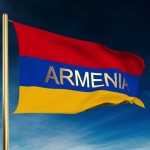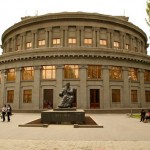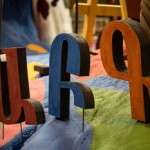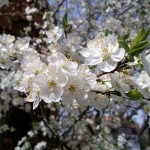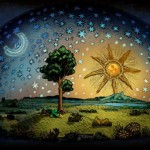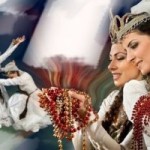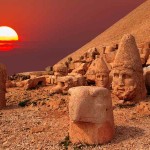
Armenian Culture
Comment are off
Architecture
Architecture occupies a unique place in Armenian culture. Since time immemorial, Armenians have been compul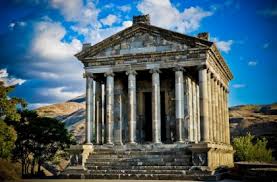 sive builders and chose to express their ingenuity, creativeness and aspirations predominantly through stone. On the territory of present-day Armenia there are some 14,000 state-protected monuments. They include megaliths, ancient altars and tombs dating 15,000 to 10,000 years back, a metal-making complex of ancient (16th century B.C.), ancient Yerevan – Erebuni (8th century B.C.), Hellenistic heathen temple of Garni (1st century).
sive builders and chose to express their ingenuity, creativeness and aspirations predominantly through stone. On the territory of present-day Armenia there are some 14,000 state-protected monuments. They include megaliths, ancient altars and tombs dating 15,000 to 10,000 years back, a metal-making complex of ancient (16th century B.C.), ancient Yerevan – Erebuni (8th century B.C.), Hellenistic heathen temple of Garni (1st century).
The proclamation of Christianity as the state religion in Armenia initiated the construction of churches and monasteries. Among most outstanding Christian monuments of Armenia are the Echmiadzin Cathedral (4th century), the Church of Ripsime (7th century), and the Church of Gegard hewn in the rocks (4th – 13th centuries), the ruins of the rotunda Chu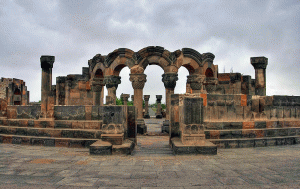 rch of Zvartnots (7th century), and the monasteries of Agartsin (11th – 12th centuries), the Tatev Monastery (9th century) and many others. These structures, as well as medieval bridges and fortresses amaze visitors by their perfection, severe forms, bold conception and grandeur. The outstanding monuments and architectural ensembles of Armenia testify to a high professional skill of its architects, sculptors and artists. Underlying their work are national traditions which evolved through the centuries and which were passed on from generation to generation. This promoted the steady progress of Armenian architecture.
rch of Zvartnots (7th century), and the monasteries of Agartsin (11th – 12th centuries), the Tatev Monastery (9th century) and many others. These structures, as well as medieval bridges and fortresses amaze visitors by their perfection, severe forms, bold conception and grandeur. The outstanding monuments and architectural ensembles of Armenia testify to a high professional skill of its architects, sculptors and artists. Underlying their work are national traditions which evolved through the centuries and which were passed on from generation to generation. This promoted the steady progress of Armenian architecture.
Music
One of the most important parts of Armenian culture is the music. Armenians love music, and they have been creating exquisite compositions for centuries. The sacred music appeared in IV-X cc., after the adoption of Christianity (301). After the invention of the Armenian alphabet, M.Mashtots and S.Partev have translated the Bible and the Holy Liturgy, arranged the musical part of the Liturgy and the church ceremonies, and became founders of the Armenian sacred music. The per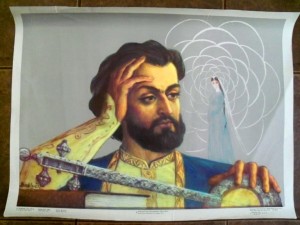 iod of X-XIV cc. was the time of the blossom of the ‘tagh’ (spiritual hymn) art. A new monumental-decorative style was developed. Grigor Narekatsi (X c.) and Nerses Shnorhali (XII c.) were the brightest representatives of the style. In the person of Sayat-Nova; the ‘ashough’ (bard) art was developed. The new so-called ‘tagh-singers’ arose: Naghash Hovnatan, Paghtasar Dpir, Petros GhapantsiThe professional composition school was formed in XIX c. In the same time, the national ‘ashough’ school was established (Shirin, Jivani). In 1868, Tigran Chukhadjyan composed the first opera (“Arshak II”).In 1880’ths, Ch.Kara-Murza, M.Yekmalyan and Komitas started to polyphonize Armenian monody songs. Komitas is one of the greatest figures of the Armenian music. He is the founder of the national composition school. He has created the masterpieces of the Armenian polyphonic vocal music, being the founder and the brightest representative of the musical ethnology. The art of Aram Khachatrian is a great phenomenon of the world music, which h
iod of X-XIV cc. was the time of the blossom of the ‘tagh’ (spiritual hymn) art. A new monumental-decorative style was developed. Grigor Narekatsi (X c.) and Nerses Shnorhali (XII c.) were the brightest representatives of the style. In the person of Sayat-Nova; the ‘ashough’ (bard) art was developed. The new so-called ‘tagh-singers’ arose: Naghash Hovnatan, Paghtasar Dpir, Petros GhapantsiThe professional composition school was formed in XIX c. In the same time, the national ‘ashough’ school was established (Shirin, Jivani). In 1868, Tigran Chukhadjyan composed the first opera (“Arshak II”).In 1880’ths, Ch.Kara-Murza, M.Yekmalyan and Komitas started to polyphonize Armenian monody songs. Komitas is one of the greatest figures of the Armenian music. He is the founder of the national composition school. He has created the masterpieces of the Armenian polyphonic vocal music, being the founder and the brightest representative of the musical ethnology. The art of Aram Khachatrian is a great phenomenon of the world music, which h ad a significance of an upheaval; he has created the first national ballet (“Gayane”), symphonies, instrumental concertos, etc. Contemporary music comes in the forms of jazz, folk and pop. The Sayat Nova Conservatory helps polish future generations of Armenian musicians. Frequent concerts make for delightful evenings at the Philharmonic, Chamber Music Hall, Opera and Ballet House in Yerevan.
ad a significance of an upheaval; he has created the first national ballet (“Gayane”), symphonies, instrumental concertos, etc. Contemporary music comes in the forms of jazz, folk and pop. The Sayat Nova Conservatory helps polish future generations of Armenian musicians. Frequent concerts make for delightful evenings at the Philharmonic, Chamber Music Hall, Opera and Ballet House in Yerevan.
Duduk( Armenian oboe )
T he duduk is one of the oldest double reed instruments in the world which dates back over 3,000 years. The duduk was introduced to western popular music through Peter Gabriel’s soundtrack album Passion for the controversial film The Last Temptation of Christ (1988), which featured virtuoso duduk player Vatche Hovsepian. Duduk performances, with its haunting exotic sound, have since become a commonplace in film and television scores. The current trend for using it in film and television was started by the world-renowned duduk player Djivan Gasparyan who collaborated with composer Hans Zimmer for the film Gladiator (2000).
he duduk is one of the oldest double reed instruments in the world which dates back over 3,000 years. The duduk was introduced to western popular music through Peter Gabriel’s soundtrack album Passion for the controversial film The Last Temptation of Christ (1988), which featured virtuoso duduk player Vatche Hovsepian. Duduk performances, with its haunting exotic sound, have since become a commonplace in film and television scores. The current trend for using it in film and television was started by the world-renowned duduk player Djivan Gasparyan who collaborated with composer Hans Zimmer for the film Gladiator (2000).
At 2005, UNESCO issued a proclamation naming duduk music a “Masterpiece of the Oral and Intangible Heritage of Humanity.”
Dance
The Armenian dance heritage has been one of the 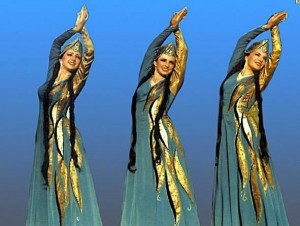 oldest, richest and most varied in the Near East. From the fifth to the third millennia B.C., in the higher regions of Armenia there are rock paintings of scenes of country dancing. These dances were probably accompanied by certain kinds of songs or musical instruments. In the fifth century Moses of Khorene (Movses Khorenats’i) himself had heard of how the old descendants of Aram (that is Armenians) make mention of these things (epic tales) in the ballads for the lyre and their songs and dances. Armenian dance is distinct by its vitality, and it used to be that every region or even every village had its own unique dance.
oldest, richest and most varied in the Near East. From the fifth to the third millennia B.C., in the higher regions of Armenia there are rock paintings of scenes of country dancing. These dances were probably accompanied by certain kinds of songs or musical instruments. In the fifth century Moses of Khorene (Movses Khorenats’i) himself had heard of how the old descendants of Aram (that is Armenians) make mention of these things (epic tales) in the ballads for the lyre and their songs and dances. Armenian dance is distinct by its vitality, and it used to be that every region or even every village had its own unique dance.
Literature
Literature has always played a vital role in Armenia’s cultural and national identity. Before the Armenian alphabet was developed in the 5th century, Armenian tales were passed down by oral tradition and written in foreign languages. Armenian manuscripts, beautifully illuminated with miniatur es, combine Armenia’s literary and illustrative traditions. Christian culture and the invention of the Armenian alphabet by Mesrop Mashtots, so thoroughly expressive of the language that it has withstood the centuries without any essential changes, gave new stimulus to the development of unique cultural traditions. There is no better place to view this literary and artistic history than Yerevan’s unique Matenadaran (Institute of Ancient Manuscripts), which houses an extraordinary collection of 14,000 complete manuscripts, fragments and miniatures. The oldest parchments date back to the fifth and sixth centuries.
es, combine Armenia’s literary and illustrative traditions. Christian culture and the invention of the Armenian alphabet by Mesrop Mashtots, so thoroughly expressive of the language that it has withstood the centuries without any essential changes, gave new stimulus to the development of unique cultural traditions. There is no better place to view this literary and artistic history than Yerevan’s unique Matenadaran (Institute of Ancient Manuscripts), which houses an extraordinary collection of 14,000 complete manuscripts, fragments and miniatures. The oldest parchments date back to the fifth and sixth centuries.
Painting
Armenian painting blossomed i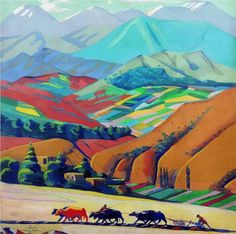 n the 19th century. Artists from that period, such as the portrait painter Hakob Hovnatanian and the seascape artist Ivan Aivazovsky, continue to enjoy international reputation. In the 20th century, Martiros Saryan captured nature’s essence in a new light, and Arshile Gorky greatly influenced a generation of young American artists in New York, while Carzou and Jansem found fame and fortune painting in France. A visit to Saryan Park in Yerevan will bring you in touch with today’s Armenian artists.
n the 19th century. Artists from that period, such as the portrait painter Hakob Hovnatanian and the seascape artist Ivan Aivazovsky, continue to enjoy international reputation. In the 20th century, Martiros Saryan captured nature’s essence in a new light, and Arshile Gorky greatly influenced a generation of young American artists in New York, while Carzou and Jansem found fame and fortune painting in France. A visit to Saryan Park in Yerevan will bring you in touch with today’s Armenian artists.
Khachkar (Cross-stone)
Khachkar (” Խաչքար ” in Armenian, literally meaning “cross-stone”) is a memorial stone with an ornamentally carved cross, accompanied by vegetative-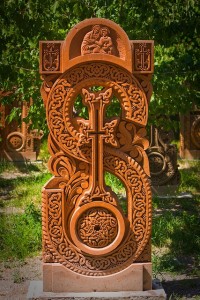 geometric motifs and sometimes with carvings of animals or people. They are unique phenomenon in the medieval Christian culture. The first true khachkars appeared in the 9th century, during the time of Armenian revival after liberation from Arab rule. The oldest khachkar with a known date was carved in 879 (though earlier, cruder, examples exist). The peak of the khachkar carving art was between the 12th and the 14th centuries. The art declined during the Mongol invasion at the end of the 14th century. It revived in the 16th and 17th centuries, but the artistic heights of the 14th century were never achieved again. Today, the tradition still remains, and one can still see khachkar carvers in some parts of Yerevan. About 40,000 khachkars survive today. Most of them are free standing, though those recording donations are usually built into monastery walls.
geometric motifs and sometimes with carvings of animals or people. They are unique phenomenon in the medieval Christian culture. The first true khachkars appeared in the 9th century, during the time of Armenian revival after liberation from Arab rule. The oldest khachkar with a known date was carved in 879 (though earlier, cruder, examples exist). The peak of the khachkar carving art was between the 12th and the 14th centuries. The art declined during the Mongol invasion at the end of the 14th century. It revived in the 16th and 17th centuries, but the artistic heights of the 14th century were never achieved again. Today, the tradition still remains, and one can still see khachkar carvers in some parts of Yerevan. About 40,000 khachkars survive today. Most of them are free standing, though those recording donations are usually built into monastery walls.
Carpet making
The Caucasus region and Armenia in particular have been cited by scholars as the place where rug and carpet weaving originated. Carpets have been woven in all the provinces of historical Armenia since olden days. Armenian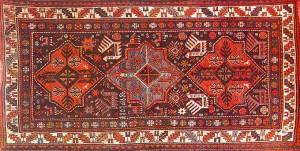 s continue this tradition, and one can find many shops specializing in fine new and old rugs and carpets. At the weekend flea market, rug sellers lay out their eye-catching merchandise filled with appealing colors and designs. Carpet making is not only a fine art, but Kilim weaving, for example, is applied to clothing items, bags, and home furnishings.
s continue this tradition, and one can find many shops specializing in fine new and old rugs and carpets. At the weekend flea market, rug sellers lay out their eye-catching merchandise filled with appealing colors and designs. Carpet making is not only a fine art, but Kilim weaving, for example, is applied to clothing items, bags, and home furnishings.

